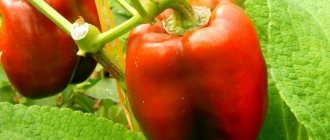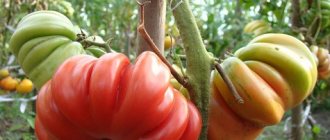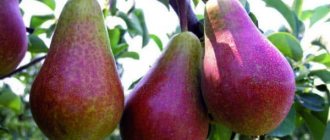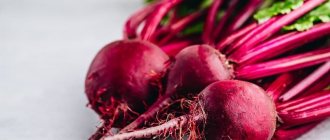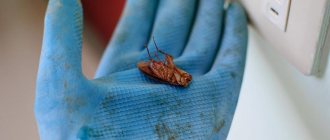Gardeners looking for tomato varieties with great taste, attractive appearance and rich biochemical composition should pay attention to yellow-fruited tomatoes. Such berries contain a lot of useful substances; they are safe for allergy sufferers and children, as they contain a minimal amount of allergens. They are recommended for dietary nutrition and treatment for vitamin deficiency.
Among the variety of similar tomato varieties, the Yellow Giant stands out. Summer residents fell in love with it for its rich sweet taste and large fruit size. Read on to learn about other advantages and features of this tomato, as well as the secrets of its agricultural technology.
Characteristics and description of the variety
Yellow Giant is a tomato variety bred by Russian breeders. Its originator is the notorious.
Note! Seeds obtained from the fruits of the Yellow Giant are suitable for planting. Planting material is collected from tomatoes that have ripened on the bushes. They are washed, cleared of pulp, dried and stored in fabric bags.
Distinctive features
This tomato produces bright yellow fruits. They are large in size and, with proper care, reach a weight of 500 g.
The fruit tastes sweet with mild sourness and a rich tomato aroma. The pulp is dense and juicy.
Yellow berries have an increased content of nutrients. Their color is due to the presence of beta-carotene (a precursor to vitamin A). It has a positive effect on visual acuity, increases immunity, normalizes metabolism and promotes the growth of the child’s body.
Tomatoes contain niacin, which strengthens the elements of the circulatory system and the heart muscle. Lycopene, which is found in yellow berries more than in tomatoes of other colors, has a positive effect on the condition of the entire body.
Among the negative features of the variety is its low resistance to tomato diseases. The yellow giant needs regular treatment against infections and insects.
Main characteristics
The parameters of the Yellow Giant will attract experienced gardeners who are ready to pay attention to tomatoes to obtain a bountiful harvest.
Characteristics and description of the culture are presented in the table:
| Parameter | Indicators |
| Bush type | Indeterminate variety. The main stem has unlimited growth and reaches a height of 1.8 m. The stems are strong and thick. The bushes are covered with an average amount of foliage. There are many stepsons. The leaves are simple, standard size, deep green. Fruits are formed individually. The inflorescences are simple. |
| Growing method | Heat-loving tomato. They are grown mainly in greenhouses. Not suitable for northern regions with short summers. |
| Productivity | High: up to 5.5 kg of berries are obtained from 1 bush. |
| Fruit | Large ones. The weight of 1 berry varies between 300–500 g. The color of the fruit is bright yellow inside and outside. There is no green spot at the base. The shape is round, flattened, with ribbing at the base. Inside there are a large number of chambers with an average number of seeds. The pulp is tender, dense, but juicy. The taste is sweet with unexpressed sourness and rich tomato aroma. |
| Transportability | Average. The skin is thin but durable. During transportation, the fruits do not crack. Can be stored for no more than 2 weeks. |
| Ripening time | Mid-season variety. The fruits ripen 110–150 days after the first shoots appear. Fruiting continues until the first frost. |
| Disease resistance | Immunity is low. |
Tomato Yellow Giant. SeDeK
Sowing tomato seeds
On the day of sowing, the soil in the containers is moistened and leveled. Then grooves are made 1 cm deep with a distance between similar grooves of 5 - 6 cm. Each seed is placed at a distance of two centimeters from the next. Sprinkle the furrow with a layer of soil mixture on top. Additional watering is not required for planted seeds.
Boxes with containers are placed on the south side of the house so that sunlight can penetrate into the room. The room temperature should be on average about +22 - 25 degrees.
A week after germination, picking is carried out and the tomatoes are transplanted into another container.
See also
Characteristics and description of the tomato variety Doll MashaRead
How to grow seedlings
Yellow giant seeds are germinated 2 months before planting in open ground. In the southern regions they begin to do this in the last days of February, in the central regions - in the second half of March.
Some gardeners advise planting seeds according to the lunar calendar. Plants that began to grow on a suitable lunar day will be stronger and healthier.
Seed preparation
To test the seeds for germination, they are soaked in a salt solution for half an hour. To prepare the product, dissolve 0.5 teaspoons of salt in 100 ml of water. Those specimens that float to the surface are unsuitable for planting.
If purchased tomato seeds were used, then most likely they will be treated at the factory. Information about this is indicated on the packaging.
Planting material obtained from its own fruits is disinfected. It is soaked:
- for 30 minutes in a light pink solution of potassium permanganate;
- for 15 minutes in hydrogen peroxide;
- for 12 hours in aloe juice diluted with water (1:1);
- for 12 hours in a soda solution (1 teaspoon of soda per 1 cup of water).
Next, seed germination is stimulated by soaking them in nutrients:
- "Epine";
- sodium humate;
- "Effectone";
- ash solution (1 tbsp. ash per 1 tbsp. water);
- honey solution (1 teaspoon of honey per 1 cup of water).
Selection of containers and soil
Any wide containers are suitable for sowing seeds. Plant seedlings into pots with a volume of at least 300 ml.
Growing containers are disinfected. They are soaked for 30 minutes in a dark pink solution of potassium permanganate.
You can buy the soil at the store or prepare it yourself. In the first case, choose special soil for tomatoes and peppers or a universal seedling mixture.
It is not difficult to prepare the soil yourself. To do this take:
- 1/3 bucket of peat;
- 1/3 bucket of humus;
- 1/3 bucket of garden soil;
- 1 teaspoon each of superphosphate, urea and potassium.
All ingredients are thoroughly mixed. Then the soil is watered with a strong solution of potassium permanganate or calcined in the oven.
The best containers for seedlings, what volume for early sowing tomatoes
Sowing
Soil is poured into the box and watered with warm water. Furrows are made in the soil 1 cm deep at a distance of 4 cm. Seeds are placed in them at intervals of 2 cm.
The grooves are sprinkled with earth and moistened with a spray bottle. The containers are covered with film and placed in a warm place.
Seedling care
To grow healthy seedlings, you need to properly care for them. The list contains the main recommendations:
- After the first shoots appear, the film is removed. Plants are moved to a well-lit place.
- Water the seedlings as the soil dries out. For irrigation, use liquid at room temperature. It should not get on the above-ground parts of plants.
- When real leaves appear, the tomatoes are planted in individual pots. Fine crushed stone or broken ceramic dishes are poured into the bottom of the containers as drainage.
- 2 weeks after transplantation, the tomatoes are fed and watered for the first time.
- In total, during the growing period, 3 feedings are applied with a break of 2 weeks. Complex mineral fertilizers and vermicompost are used.
- 10 days before planting tomatoes in a permanent place, they begin to harden. The seedlings are taken out onto the balcony or street. The procedure begins at 1 hour, gradually increasing the time to 16 hours.
Planting tomato seedlings
Sowing seeds to obtain seedlings is carried out in the last week of February. At least 2 months must pass before planting in the soil or in a greenhouse.
The best indicators of germination, growth and yield of tomatoes from seeds purchased in specialized stores. If you plan to collect seeds from your harvest, you should leave them on the bushes until they are fully ripe, choosing the fruits of the most correct shape. After picking, the tomatoes are placed on the windowsill on the sunny side of the house. After the fruits become soft, their middle is taken into a container with water and kept in it for 2 - 3 days. Then the seeds are washed and laid out on a flat surface, for example, on a paper sheet to dry.
Before sowing, it is advisable to treat tomato seeds with a special solution. It can be prepared by diluting one of the following products in 1 liter of water: liquid fertilizers (“Agricola-vegeta” and “Effecton”), nitrophoska or wood ash. Soak the seeds for 1 day, and then take them out, dry them slightly, place them in a sealed bag and put them in the refrigerator. This procedure promotes seed hardening. After two days in the refrigerator, the seeds can be planted in the soil.
Agricultural technology of the Yellow Giant
Seedlings are planted in a permanent place when the soil at a depth of 15 cm warms up. Plants are planted in the greenhouse 2 weeks earlier.
Before picking, you need to make sure the quality of the tomato seedlings. This information will also be useful to those gardeners who prefer to buy already grown plants:
- Seedlings must be no younger than 45 days and no older than 50.
- The height of the stem is within 25–35 cm. By this time, about 11 leaves should have formed on the plant.
- The stem of a tomato is no thinner than a pencil. The foliage is bright green.
- Leaves and stem are uniform in color. Spots on the ground part of the plant indicate that the seedlings are of poor quality.
- The above-ground part of the plants should not look lethargic.
Landing
Prepare the soil for tomatoes in the fall. Rotted manure (4 kg per 1 m2) is spread over the beds. The soil is dug up to a depth of 30 cm. During the process, plant remains are removed and the soil is mixed with fertilizers.
In spring, the ground is leveled with a rake. Add 1 tbsp per 1 m2. a spoonful of superphosphate and potassium chloride.
The holes are dug in rows in a checkerboard pattern. 3-4 plants are placed per 1 m2.
1 tbsp is poured into the holes. a spoonful of ash or long-acting granular fertilizers. One bush taken from the pot along with a lump of earth is placed in each recess. 1 liter of water is poured into the holes and covered with earth.
Caring for mature plants
Tall tomatoes need to be tied up. As they grow, they are attached to wooden supports or trellises with synthetic thread.
Form bushes with 1 or 2 stems. In the first case, the tomato fruits will be larger, and in the second, the yield will increase.
During pinching, the leaves below 1 cluster are removed. Wilted greens are also removed.
Water the tomatoes as the soil dries. One plant will need 2-3 liters of water. It is important that the liquid does not fall on the above-ground part of the plants.
After each watering and rainfall, the tomato beds are loosened. For the first 2 weeks, the loosening depth is 15 cm, then 8 cm. During this procedure, all weeds are removed from the tomato beds.
After flowering begins, tomato bushes need to be shaken periodically. This will speed up fruit set.
Fertilizers are applied 3 times per season. Many gardeners use the following scheme:
- The first time fertilizing is applied 2 weeks after picking the tomatoes. For these purposes, use a mixture prepared from 10 liters of water and 1 kg of chicken manure. The composition is infused for 3 days. For each plant 1 liter of fertilizer.
- After the first ovaries appear on 2 brushes, a second feeding is applied. It is prepared from 10 liters of water, 3 g of copper sulfate, 3 g of potassium permanganate, 3 g of “Solution” and 1 kg of bird droppings. 2 liters of the mixture are poured onto 1 bush.
- The same nutrient solution is used to feed tomatoes during the fruiting period.
Possible difficulties
When growing Yellow Giant there is a risk of a number of problems. Let's look at the most common of them:
- Plants lost turgor after feeding. This happens if fertilizers are applied without prior watering. Therefore, thoroughly moisten the soil before the procedure.
- Too much greenery is formed, which indicates that an excessive amount of fertilizing has been applied.
- The plant produces few ovaries, the leaves fall off and change color. This occurs due to lack of nutrients.
Diseases and pests
The Yellow Giant tomato has low immunity to diseases of nightshade crops. It is often affected by fungal infections . To protect plants, there are rules of prevention:
- The Yellow Giant is planted only in prepared beds. They must be disinfected and cleaned of plant debris.
- Tomatoes should not be planted in beds where other nightshade crops previously grew. Potatoes are not grown next to tomato beds.
- All objects with which plants will interact are disinfected.
- It is important to follow the rules of watering and pinching. Their violation will increase the risk of plant infection.
- Bushes are regularly sprayed with a solution of copper sulfate or potassium permanganate to protect against fungal infections.
- To reduce the likelihood of tomatoes being affected by late blight, hang an open bottle of iodine in the greenhouse.
- To protect tomatoes from insects (aphids, Colorado potato beetles, slugs, caterpillars, etc.), they are treated with a soap solution and a decoction of celandine. Large pests are removed manually.
If it was not possible to protect the plant, it may be affected by the following diseases:
- Late blight. It is caused by a representative of mushroom-like protists - late blight. When infected, ripe and green tomatoes become covered with dark spots. In greenhouse conditions with high humidity, suitable for the spread of infection, a white coating forms on the back of the leaves. Sick bushes cannot be saved; they are destroyed. Fungicides (for example, Bordeaux mixture) are used for treatment. For preventive purposes, healthy tomatoes are sprayed with a light pink solution of potassium permanganate, and immediately after planting in the ground they are treated with Fitosporin-M.
- Tobacco mosaic. A viral disease that is extremely difficult to cure. When affected, the leaves become deformed and become covered with dry spots, and the fruits become smaller. As a result, the plant dies. Infected bushes are immediately removed along with a lump of earth and burned. To prevent the spread of infection, the rules of agricultural technology should be followed.
- Powdery mildew is a fungal disease in which leaves become covered with white spots, begin to wither and fall off. To save tomatoes, the affected parts are torn off, the cut points and spots are sprinkled with ash. Diseased leaves are removed and burned. Plants and soil are sprayed with a weak solution of potassium permanganate (1 g of powder per 10 ml of water) or special biological products (Epin, humates, etc.). For prevention, bushes are treated against pests, the soil is loosened more often, and the greenhouse is ventilated when growing in it.
Powdery mildew (control methods and prevention)
The nuances of cultivation in open and protected ground
Yellow giant tomatoes are grown mainly in greenhouses. In such conditions, productivity indicators are as high as possible. Before planting tomatoes, the walls of the room are treated with copper sulfate.
Indoors, infections spread faster. To reduce the risk of plant infection, you need to open the windows daily to ventilate the space. In such conditions, tomatoes are watered less frequently than in garden beds. In the first case, the soil is moistened once a week, and in the second - 2-3.
Growing the Yellow Giant in open ground is possible only in the southern regions. To do this, cover the tomatoes with film for the first 2 weeks after picking and during cold spells.
Growing conditions
The bed for planting tomatoes must be prepared in the fall. It is plowed and fertilized (per 1 square meter 30–40 g of superphosphates and 25–30 g of potassium fertilizers). Soil acidity should be 6.5 pH. If it is increased, then add 0.5–0.9 kg of lime, 5–7 kg of organic matter and 40–60 g of superphosphates.
When growing tomatoes in a greenhouse, the air humidity should be 60–70%, and the temperature should be up to 23°C until shoots appear; then it should be lowered to 10–15°C during the daytime and 8–10°C at night.
The best tomato predecessors:
- cucumbers;
- cabbage;
- zucchini;
- onion.
In an area where peppers, potatoes or eggplants grew, tomatoes can only be planted a few years later.
Harvesting and application
The first fruits of the Yellow Giant will ripen at the end of July. They are plucked from the bush one by one, preserving the stalk.
On cloudy days, unripe berries are also picked: they ripen in the warmth at home.
The Yellow Giant is used for raw consumption. It is not suitable for conservation due to its large size. The berries make delicious juices and sauces.
Farmer reviews
Yellow giant tomatoes have conflicting reviews. This variety has excellent taste and good yield, but has weak immunity to diseases:
Alina, Sochi: “I’ve been growing Yellow Giant in a greenhouse for 2 years now. The variety requires regular care. It is susceptible to diseases such as late blight and tobacco mosaic. However, all the difficulties of growing it pay off. The variety has very large and very tasty yellow fruits, as in the photo. My kids just love them."
Evgeniy, Tver: “I tried to grow the Yellow Giant last year. I sprayed it regularly, but did not spray it with antifungal agents. As a result, all the bushes were affected by late blight. I’ll try to plant this year, taking into account past mistakes.”


